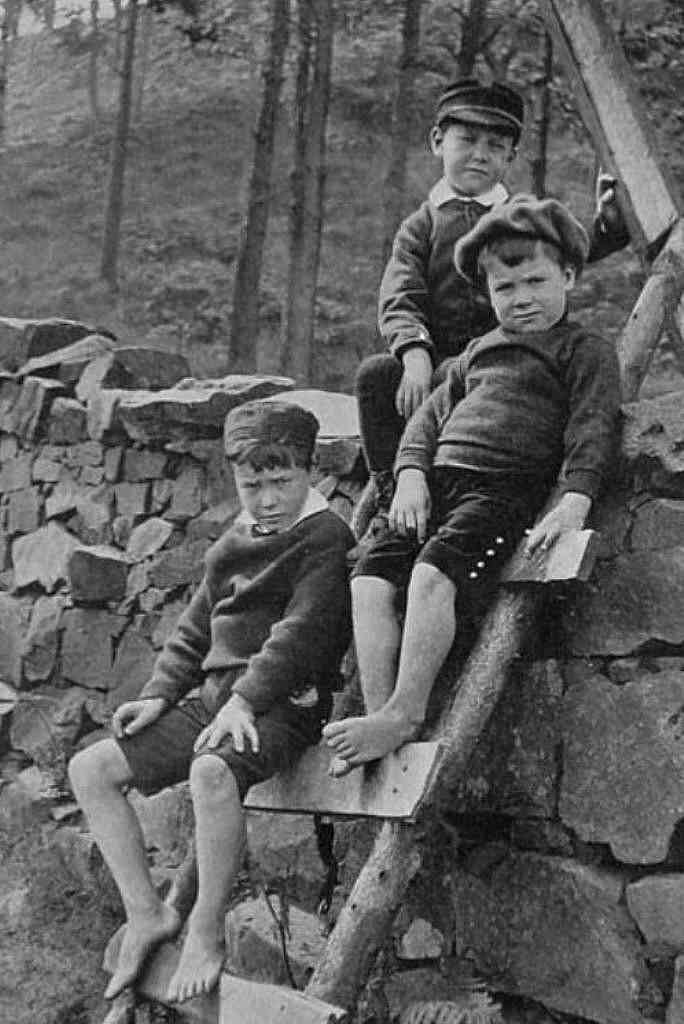
Scottish Boys' Clothes: Early-20th Century (1900-18)

Figure 1.--This photohraph of three Scottish boys was taken in 1910 by Thomas Nisbet. The boys are wearing sweaters and knee pants. One boy wears long stockings and high-top shoes. The other two boys are barefoot. Notice the interesting headwear. One boy wears a military-style cap. I'm not sure how to descrribe the brimless cap the boy at the left wears. The younger boy wears a tam. The photograph itself is interesting. The ladder the boys re sitting on was built to provide a way of getting over the stonewall. It was easier to build this than a gate. This clearly places the boys in a rural area.
|
|
We believe that Scottish boys in the early 20th century dressed much like English boys. We see many boys wearing knee pnts suits. The basic differnce seems to have been that Scotland was not as prosperous as England. We seem to see more boys going barefoot in Scotland. than England, although this is a little difficult to quantify using available photographic images. Of course Scotland is known for the kilt. We are unsure how extensively the kilt was worn by Scottish boys in the early-20th century. In particular I do not known how common it was for parents to dress boys in kilts for everyday wear. I think that it was probably not extremely common as the kilt was a more expensive garment than knee pants or short pants. I think that there were some boys dressed in kilts for school and everyday wear before World War I. Strangely it seems a strange mix. We see some boys from well to-do familkies wearing kilts. And we see some boys from modest families in the Highlands and Islands. We do not see many working-class boys in the cities (Glasgow and Edinburgh) wearing kilts. Nor do the
seem common in the Lowlands (southern Scotland). Although I'd be very interested; in input from our British visitors here. The film Chariots of Fire provides some insights. The costuming for the film was extremely well researche. In it there is a church scene set in Scotland and many of the boys there are wearing kilts. We note an Edinburgh boy wearing a Fauntleroy outfit about 1910. We do not know substantial differences during the 1900s and 10s, but our archive is still very limited.
Similarity to England
We believe that Scottish boys in the early 20th century dressed much like English boys. We see many boys wearing knee pnts suits. The basic differnce seems to have been that Scotland was not as prosperous as England. We seem to see more boys going barefoot in Scotland. than England, although this is a little difficult to quantify using available photographic images.
The garments we notice in Scotland during the early 20th century sdeem bvery similar to the popular styles to the south in England. Glengarys and Balmoral caps seem nore popular in Scotland. We note an Edinburgh boy wearing a Fauntleroy outfit about 1910. We mostly notice Scottish boys wearing knee pants like Englisdgh boys. Of course Scotland is known for the kilt. We are unsure how extensively the kilt was worn by Scottish boys in the early-20th century. In particular I do not known how common it was for parents to dress boys in kilts for everyday wear. I think that it was probably not extremely common as the kilt was a more expensive garment than knee pants or short pants. I think that there were some boys dressed in kilts for school and everyday wear before World War I. Strangely it seems a strange mix. We see some boys from well to-do familkies wearing kilts. And we see some boys from modest families in the Highlands and Islands. We do not see many working-class boys in the cities (Glasgow and Edinburgh) wearing kilts. Nor do the
seem common in the Lowlands (southern Scotland). Although I'd be very interested; in input from our British visitors here. The film Chariots of Fire provides some insights. The costuming for the film was extremely well researched. In it there is a church scene set in Scotland and many of the boys there are wearing kilts. Long stockings my have been a little more common in Scotland than England, but our arechive is too small go assess this with any confidence.
Decades
We do not know substantial differences during the 1900s and 10s. So much so that it is difficult to date images from this period. Our archive is still very limited so it is difficult to make any firm assessments. We do notice verynsubstantial changes after World War I in the 1920s.
HBC

Navigate the Boys' Historical Clothing Web Site:
[Return to the Main 20th Scottish chronolgical trends page]
[Introduction]
[Activities]
[Biographies]
[Chronology]
[Clothing styles]
[Countries]
[Bibliographies]
[Contributions]
[FAQs]
[Glossaries]
[Images]
[Links]
[Registration]
[Tools]
[Boys' Clothing Home]
Navigate the Boys' Historical Clothing kilt pages:
[Main kilt page]
[Tam O'Shanter]
[Kilt suits]
[Scottish kilts]
[Scottish boys clothing]
[Scottish school uniform]
[Highland dance]
[Pipeband]
[Irish kilts]
[Irish boys clothing]
[Irish step dancing]
[Greek kilts]
Created: 6:52 PM 2/10/2009
Last updated: 4:46 AM 5/3/2011



